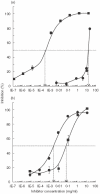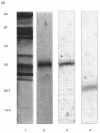Detection and identification of a soy protein component that cross-reacts with caseins from cow's milk
- PMID: 12296853
- PMCID: PMC1906491
- DOI: 10.1046/j.1365-2249.2002.t01-1-01935.x
Detection and identification of a soy protein component that cross-reacts with caseins from cow's milk
Abstract
Soy-based formulas are the most employed cow's milk substitutes in the treatment of cow's milk allergy in our country. Since adverse reactions have been reported in allergic patients as a consequence of exposure to soy proteins, we have investigated the possible cross-reactivity between components from soybean and cow's milk. A cow's milk specific polyclonal antiserum and casein specific monoclonal antibodies were used in immunoblotting and competitive ELISA studies to identify a 30-kD component from soybean that cross-reacts with cow's milk caseins. Its IgE binding capacity was tested by EAST, employing sera from cow's milk allergic patients, not previously exposed to soy proteins. The 30 kD protein was isolated and partially sequenced. It is constituted by two polypeptides (A5 and B3) linked by a disulphide bond. The protein's capacity to bind to the different antibodies relies on the B3 poly-peptide. These results indicate that soy-based formula, which contains the A5-B3 glycinin molecule, could be involved in allergic reactions observed in cow's milk allergic patients exposed to soy-containing foods.
Figures






Similar articles
-
Immunochemical characterization of Glycine max L. Merr. var Raiden, as a possible hypoallergenic substitute for cow's milk-allergic patients.Clin Exp Allergy. 2008 Sep;38(9):1559-65. doi: 10.1111/j.1365-2222.2008.03062.x. Epub 2008 Jul 9. Clin Exp Allergy. 2008. PMID: 18631353
-
In vivo and in vitro studies on the residual allergenicity of partially hydrolysed infant formulae.Acta Paediatr. 1999 Apr;88(4):394-8. doi: 10.1080/08035259950169756. Acta Paediatr. 1999. PMID: 10342536
-
Tolerance to a rice hydrolysate formula in children allergic to cow's milk and soy.Clin Exp Allergy. 2003 Nov;33(11):1576-80. doi: 10.1046/j.1365-2222.2003.01781.x. Clin Exp Allergy. 2003. PMID: 14616871 Clinical Trial.
-
Soy- and rice-based formula and infant allergic to cow's milk.Endocr Metab Immune Disord Drug Targets. 2014 Mar;14(1):38-46. doi: 10.2174/1871530314666140121144604. Endocr Metab Immune Disord Drug Targets. 2014. PMID: 24450453 Review.
-
Milk and soy allergy.Pediatr Clin North Am. 2011 Apr;58(2):407-26, x. doi: 10.1016/j.pcl.2011.02.005. Pediatr Clin North Am. 2011. PMID: 21453810 Free PMC article. Review.
Cited by
-
The Analytical Possibilities of FT-IR Spectroscopy Powered by Vibrating Molecules.Int J Mol Sci. 2023 Jan 5;24(2):1013. doi: 10.3390/ijms24021013. Int J Mol Sci. 2023. PMID: 36674526 Free PMC article. Review.
-
Soy, Soy Foods and Their Role in Vegetarian Diets.Nutrients. 2018 Jan 5;10(1):43. doi: 10.3390/nu10010043. Nutrients. 2018. PMID: 29304010 Free PMC article. Review.
-
Molecular Approaches for Diagnosis, Therapy and Prevention of Cow´s Milk Allergy.Nutrients. 2019 Jun 29;11(7):1492. doi: 10.3390/nu11071492. Nutrients. 2019. PMID: 31261965 Free PMC article. Review.
-
Targeting a cross-reactive Gly m 5 soy peptide as responsible for hypersensitivity reactions in a milk allergy mouse model.PLoS One. 2014 Jan 9;9(1):e82341. doi: 10.1371/journal.pone.0082341. eCollection 2014. PLoS One. 2014. PMID: 24416141 Free PMC article.
-
Food allergy overview in children.Clin Rev Allergy Immunol. 2008 Apr;34(2):217-30. doi: 10.1007/s12016-007-8034-1. Clin Rev Allergy Immunol. 2008. PMID: 17990125 Review.
References
-
- Bock SA, Atkins FM. Patterns of food hypersensitivity during sixteen years of double-blind, placebo-controlled food challenges. J Pediatr. 1990;117:561–7. - PubMed
-
- Sampson HA. Food allergy. Part 1: immunopathogenesis and clinical disorders. J Allergy Clin Immunol. 1999;103:717–28. - PubMed
-
- Docena G, Fernandez R, Chirdo F, Fossati C. Identification of casein as the major allergenic and antigenic protein of cow’smilk. Allergy. 1996;51:412–6. - PubMed
-
- Restani P, Gaiaschi A, Plebani A, et al. Cross-reactivity between milk proteins from different animal species. Clin Exp Allergy. 1999;29:997–1004. - PubMed
-
- Gjesing B, Osterballe O, Schwartz B, Wahn U, Lowenstein H. Allergen-specific IgE antibodies against antigenic components in cow's milk and milk substitutes. Allergy. 1986;41:51–6. - PubMed
Publication types
MeSH terms
Substances
LinkOut - more resources
Full Text Sources
Medical

